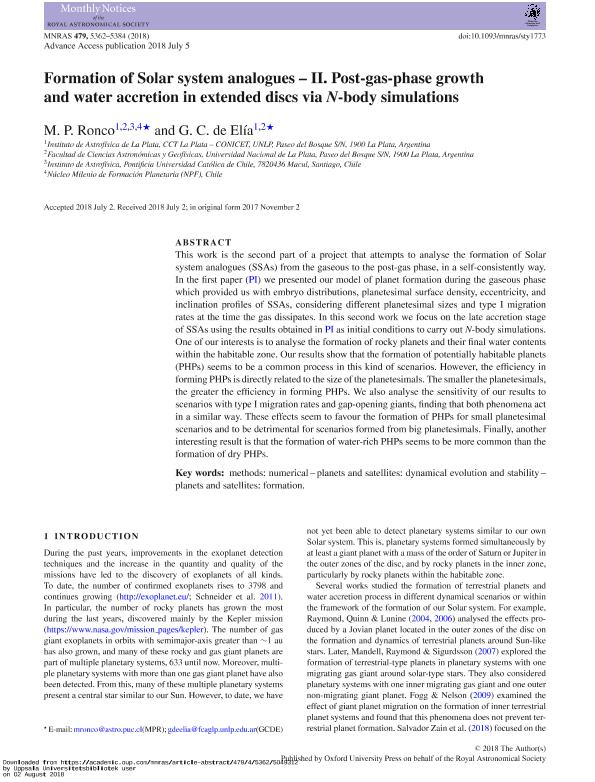Artículo
Formation of Solar system analogues – II: Post-gas-phase growthand water accretion in extended discs via N-body simulations
Fecha de publicación:
10/2018
Editorial:
Oxford University Press
Revista:
Monthly Notices of the Royal Astronomical Society
ISSN:
0035-8711
e-ISSN:
1365-2966
Idioma:
Inglés
Tipo de recurso:
Artículo publicado
Clasificación temática:
Resumen
This work is the second part of a project that attempts to analyse the formation of Solar system analogues (SSAs) from the gaseous to the post-gas phase, in a self-consistently way. In the first paper (PI) we presented our model of planet formation during the gaseous phase which provided us with embryo distributions, planetesimal surface density, eccentricity, and inclination profiles of SSAs, considering different planetesimal sizes and type I migration rates at the time the gas dissipates. In this second work we focus on the late accretion stage of SSAs using the results obtained in PI as initial conditions to carry out N-body simulations. One of our interests is to analyse the formation of rocky planets and their final water contents within the habitable zone. Our results show that the formation of potentially habitable planets (PHPs) seems to be a common process in this kind of scenarios. However, the efficiency in forming PHPs is directly related to the size of the planetesimals. The smaller the planetesimals, the greater the efficiency in forming PHPs. We also analyse the sensitivity of our results to scenarios with type I migration rates and gap-opening giants, finding that both phenomena act in a similar way. These effects seem to favour the formation of PHPs for small planetesimal scenarios and to be detrimental for scenarios formed from big planetesimals. Finally, another interesting result is that the formation of water-rich PHPs seems to be more common than the formation of dry PHPs.
Archivos asociados
Licencia
Identificadores
Colecciones
Articulos(IALP)
Articulos de INST.DE ASTROFISICA LA PLATA
Articulos de INST.DE ASTROFISICA LA PLATA
Citación
Ronco, María Paula; de Elia, Gonzalo Carlos; Formation of Solar system analogues – II: Post-gas-phase growthand water accretion in extended discs via N-body simulations; Oxford University Press; Monthly Notices of the Royal Astronomical Society; 479; 4; 10-2018; 5362-5384
Compartir
Altmétricas




